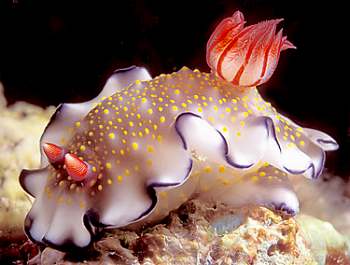
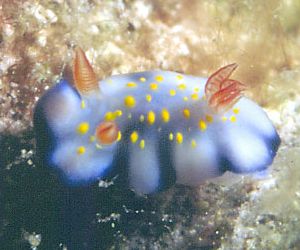
Hypselodoris bollandi
Gosliner & Johnson, 1999
Order: NUDIBRANCHIA
Suborder: DORIDINA
Superfamily: EUDORIDOIDEA
Family: Chromodorididae
DISTRIBUTION
Known from the Philippines and Okinawa.
PHOTO
Upper: Anilao, Luzon Island, Philippines, April, 2002. Lower: Juvenile animal. Anilao, Luzon Island, Philippines, (approximately 8-10mm), April, 2000. Photos: Jeff Rosenfeld
Adult Hypselodoris bollandi are very similar in external appearance to the yellow spotted species of Risbecia, R. pulchella, R. godeffroyana and R. imperialis but it differs in a number of features. Its rhinophores are translucent reddish orange and its gills are translucent white with red-orange edging. The gills of the Risbecia species are vibrate rhythmically and are arranged with secondary spirals while in H. bollandi they form a simple circle. The mantle glands in H. bollandi are restricted to the anterior and posterior ends of the mantle while in species of Risbecia there are glands down each side of the mantle as well. From the few photos available (see Gosliner & Johnson, 1999, Bob Bolland's website), in adults the blue becomes much darker and a diffuse reticulate pattern of dark blue develops over the mantle, much as in species of Risbecia.
Reference:
• Gosliner, T.M. & Johnson, R.F. (1999) Phylogeny of Hypselodoris (Nudibranchia: Chromodorididae) with a review of the monophyletic clade of Indo-Pacific species, including descriptions of twelve new species. Zoological Journal of the Linnean Society, 125: 1-114.
Rudman, W.B., 2001 (May 23) Hypselodoris bollandi Gosliner & Johnson, 1999 . [In] Sea Slug Forum. Australian Museum, Sydney. Available from http://www.seaslugforum.net/find/hypsboll
Related messages
Hypselodoris bollandi from the Philippines
June 24, 2006
From: Carlos R. Munda
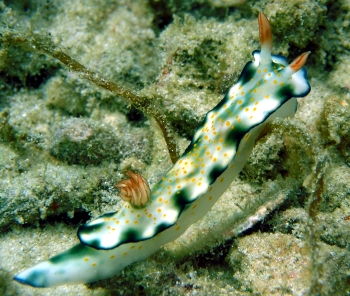
Would anyone know what kind of Hypselodoris this is? thanks
Locality: paradise beach, samal island, 20-30 feet, davao gulf, philippines, pacific, december 2006, shallow reef near beach. Length: 2 inches (approx). Photographer: carlos r. munda, jr..
Carlos R. Munda
c_munda@yahoo.com
Munda, C. R., 2006 (Jun 24) Hypselodoris bollandi from the Philippines. [Message in] Sea Slug Forum. Australian Museum, Sydney. Available from http://www.seaslugforum.net/find/16959Dear Carlos,
This is Hypselodoris bollandi
Best wishes,
Bill Rudman
Hypselodoris bollandi from Malaysia?
May 2, 2006
From: Sharif Forbes
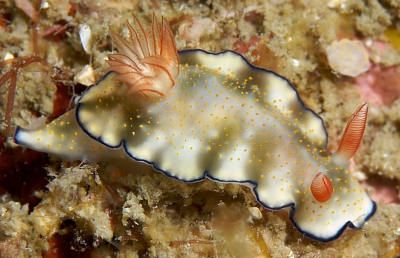
Dear Bill,
The attached specimen (about 3 cm) was photographed on 9th April at about 22 metres on the east coast of Tenggol Island, Malaysia.
Locality: Pulau Tenggol, 22 metres, Malaysia, South China Sea, 9 April 2006, steep rocky slope with encrusting corals etc. Length: 3 cm. Photographer: Sharif Forbes.
My immediate reaction is to identify it as Hypselodoris bollandi but as this species usually seems to be associated with a more easterly location (Okinawa/Philippines) maybe you could give your opinion.
Thanks
Sharif
sjforbes@micci.com
Forbes, S., 2006 (May 2) Hypselodoris bollandi from Malaysia?. [Message in] Sea Slug Forum. Australian Museum, Sydney. Available from http://www.seaslugforum.net/find/16464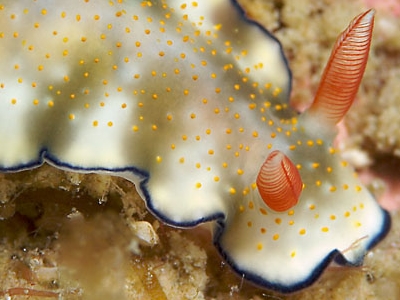
Dear Sharif,
Your first thoughts were almost certainly correct. We know very little about most of these species, so if you find something that doesn't seem to fit the known facts, your first thought should be 'I have found something we didn't know before' rather than 'I have made a mistake'. That is the excitement of our science - we all have the chance to find something new.
I am sure as more eyes - and cameras - are out recording, we will greatly increase the known range of many of these species.
Best wishes,
Bill Rudman
Hypselodoris bollandi from Philippines
May 17, 2002
From: Jeff Rosenfeld

Bill,
Here's a shot of Hypselodoris bollandi taken in Anilao, Luzon Island, Philippines in April, 2002.
It is interesting to compare it to the juvenile I photographed at the same divesite that I sent you last year.
Take care,
Jeff
jhrosenfeld@seattleschools.org
Rosenfeld, J., 2002 (May 17) Hypselodoris bollandi from Philippines. [Message in] Sea Slug Forum. Australian Museum, Sydney. Available from http://www.seaslugforum.net/find/6966Thanks Jeff,
Bill Rudman
Re: Chromodorid from the Philippines
May 25, 2001
From: Rebecca Johnson

Hi Bill,
I think Jeff Rosenfeld's little guy is Hypselodoris bollandi. The holotype is from 3km west of Anilao, found at 10m. Angel, Terry and the rest of the gang from CAS just found another near Anilao, Luzon, Philippines, 10m depth. Attached is a great photo of it taken by Angel Valdes. I hope you are feeling better. I am planning to send more posts soon.
Take care,
Rebecca
rjohnson@calacademy.org
Johnson, R., 2001 (May 25) Re: Chromodorid from the Philippines. [Message in] Sea Slug Forum. Australian Museum, Sydney. Available from http://www.seaslugforum.net/find/4411Thanks Rebecca,
Instant peer review! The photo in Gosliner & Johnson (1999) and on Bob Bolland's website certainly look a bit different. I guessed Jeff's photo was probably a juvenile but I didn't really consider H. bollandi as a possibility. It looks like Anilao is its favourite location - or at least the favourite location of those finding it! Thanks also to Angel for the photo.
Best wishes,
Bill Rudman
Chromodorid from the Philippines
May 24, 2001
From: Jeff Rosenfeld

Hi Bill,
We called this tiny guy (approximately 8-10mm) Chromodoris aureopunctata
(http://www.oz.net/~vibrant/aureopunctata22_anilao10.html). It was taken in Anilao, Luzon Island, Philippines in April, 2000.
Do you have any information about this species?
Jeff
jhrosenfeld@seattleschools.org
Rosenfeld, J., 2001 (May 24) Chromodorid from the Philippines. [Message in] Sea Slug Forum. Australian Museum, Sydney. Available from http://www.seaslugforum.net/find/4386Dear Jeff,
I am not sure whether this pretty little animal has its adult colour pattern or whether it is a juvenile. It looks a bit like Chromodoris hintuanensis in the way the obscure purple network is arranged and also looks a bit like Risbecia godeffroyana but 'looking like' doesn't really mean anything.
Basically I can't place it. It certainly isn't Noumea aureopunctata nor typical of any other named yellow-spotted species. I guess it is either a species of Chromodoris or a juvenile of a species of Risbecia. If you, or anyone has further photos of this animal or can identify it I would be grateful
Best wishes,
Bill Rudman
